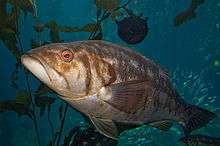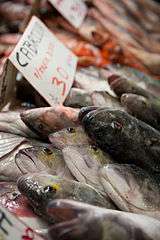Paralabrax
| Paralabrax | |
|---|---|
 | |
| kelp bass (Paralabrax clathratus) | |
| Scientific classification | |
| Kingdom: | Animalia |
| Phylum: | Chordata |
| Class: | Actinopterygii |
| Order: | Perciformes |
| Suborder: | Percoidei |
| Superfamily: | Percoidea |
| Family: | Serranidae |
| Subfamily: | Serraninae |
| Genus: | Paralabrax Girard, 1856 |
| Species | |
|
9 | |
Paralabrax is a genus of fishes in the family Serranidae. They are known commonly as rock basses.[1] The nine species in the genus are native to rocky reef habitat in the eastern Pacific and western Atlantic Oceans, where they are often dominant predators in the ecosystem.[1] They are also commercially important in local fisheries.[1]
Biology
Like many fish in the family Serranidae, some Paralabrax species are hermaphrodites, specifically protogynous hermaphrodites, which are female when young and eventually change into males. Others are gonochores, with individuals being either male or female and never changing sex. Gonochores in this genus are thought to be "secondary gonochores", species with ancestors that were hermaphrodites and lost the ability to change sex. An exception is the barred sand bass (P. nebulifer), which is a gonochore which has retained the ability.[2] In addition, the spotted sand bass (P. maculatofasciatus) appears to be flexible, with some populations made up of gonochores and some made up of hermaphroditic individuals.[3]
Paralabrax species generally spawn early in summer, their larvae joining the ichthyoplankton when the water is warmest.[4]
Economic importance

Several species are of economic importance as food fish. The spotted sand bass (P. maculatofasciatus) is harvested in the commercial fishing industry and is caught for subsistence.[5]
Some of these fish are also popular catches in recreational fishing. The kelp bass (P. clathratus) and barred sand bass (P. nebulifer) are sought after in the waters along the coast of Southern California and northern Baja California, where they have both been in the top three species caught on commercial sportfishing tours.[6]
Systematics
This genus is a basal clade in the Serraninae, the basal subfamily in the family Serranidae. In terms of its evolutionary history, these fish species have characteristics that were present in the earliest known members of the family.[1][7] A phylogenetic analysis showed that the Graery threadfin seabass (Cratinus agassizii) is the sister taxon to genus Paralabrax.[1]
Species include:[8]
- Paralabrax albomaculatus – camotillo
- Paralabrax auroguttatus – goldspotted sand bass
- Paralabrax callaensis – southern rock bass
- Paralabrax clathratus – kelp bass
- Paralabrax dewegeri – vieja
- Paralabrax humeralis – Peruvian rock seabass
- Paralabrax loro – parrot sand bass
- Paralabrax maculatofasciatus – spotted sand bass
- Paralabrax nebulifer – barred sand bass
References
| Wikimedia Commons has media related to Paralabrax. |
- 1 2 3 4 5 Pondella, D. J., et al. (2003). The phylogeny of Paralabrax (Perciformes: Serranidae) and allied taxa inferred from partial 16S and 12S mitochondrial ribosomal DNA sequences. Molecular Phylogenetics and Evolution 29, 176-84.
- ↑ Hovey, C. B., et al. (2002). The reproductive pattern of barred sand bass (Paralabrax nebulifer) from southern California. California Cooperative Oceanic Fisheries Investigations Report 43 174-81.
- ↑ Hovey, T. E. and L. G. Allen. (2000). Reproductive patterns of six populations of the spotted sand bass, Paralabrax maculatofasciatus, from Southern and Baja California. Copeia 2000(2) 459-68.
- ↑ Oda, D. L., et al. (1993). Reproductive biology of three California species of Paralabrax (Pisces: Serranidae). California Cooperative Oceanic Fisheries Investigations Report 34, 122-32.
- ↑ Loflen, C. L. (2013). Examination of spotted sand bass (Paralabrax maculatofasciatus) pollutant bioaccumulation in San Diego Bay, San Diego, California. PeerJ 1:e213 DOI 10.7717/peerj.213.
- ↑ Love, M. S., et al. (1996). Aspects of the life histories of the kelp bass, Paralabrax clathratus, and barred sand bass, P. nebulifer, from the southern California Bight. Fishery Bulletin 94(3), 472-81.
- ↑ Sadovy, Y. and M. L. Domeier. (2005). Perplexing problems of sexual patterns in the fish genus Paralabrax (Serranidae, Serraninae). Journal of Zoology 267(2), 121-33.
- ↑ Froese, R. and D. Pauly, eds. Species List: Paralabrax. FishBase. 2014.
External links
- Kelp Bass on Exhibit. Monterey Bay Aquarium.